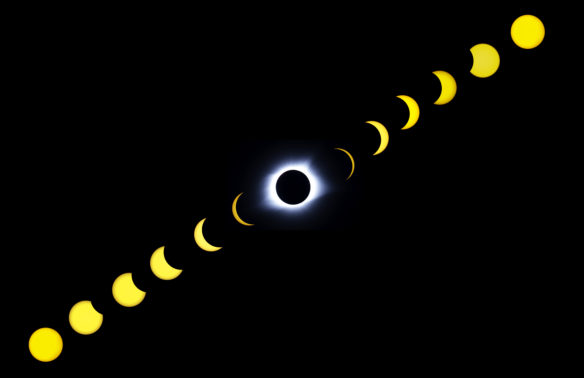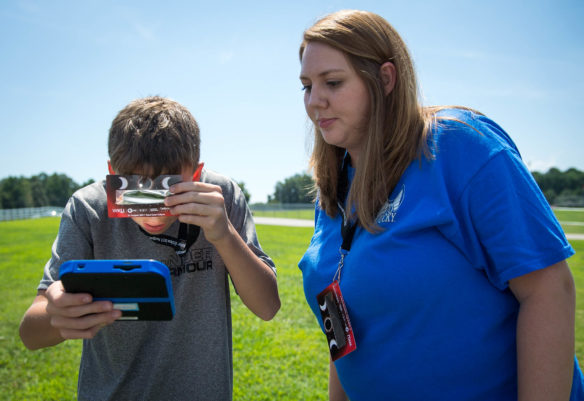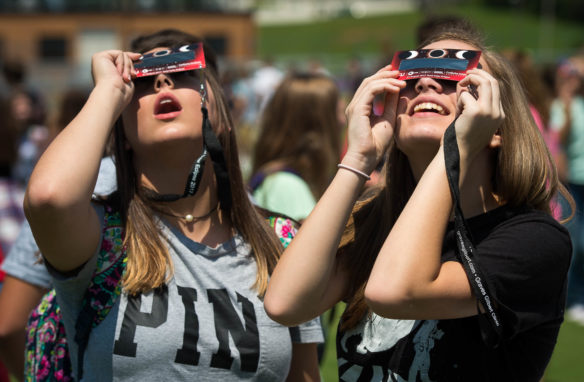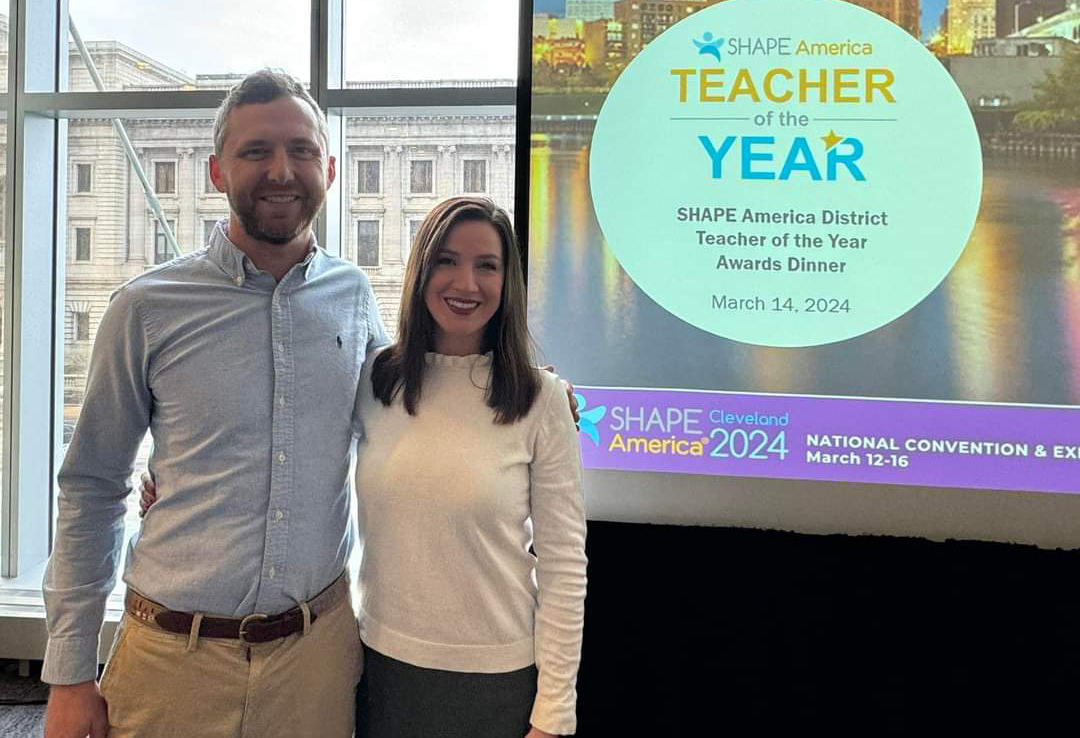
A composite image taken from outside Allen County-Scottsville High School (Allen County) shows the Aug. 21 solar eclipse before, during and after totality. Students at four Allen County schools viewed the eclipse during the school day, and teachers and administrators planned for months to make the event a safe, memorable and educational experience for the students.
Photo by Bobby Ellis, Aug. 21, 2017
By Mike Marsee
mike.marsee@education.ky.gov
The sky went dark, the students gasped and the teachers who surrounded them breathed a sigh of relief.
Months of planning across the district for an event that lasted less than 2 minutes – last month’s total solar eclipse – had culminated in an unforgettable experience for Allen County students.
Students at Allen County-Scottsville High School, James E. Bazzell Middle School, Allen County Intermediate Center and Allen County Primary Center gathered on four different fields on the schools’ shared campus on Aug. 21 to view the eclipse under the supervision of teachers, administrators and other staff members.
“I think it’s one of those things where everybody can say, ‘Wow! We did that!’” said Rick Fisher, the district’s assistant superintendent for instruction. “We’re very proud of this district, and I think everybody who works here takes everything with a lot of pride. Today we walk around like we just had a big win, like, ‘Wow, we had an amazing day.’ We’re all feeling really happy and satisfied.”
The teamwork necessary to make the experience safe, memorable and educational for about 3,000 students set an example that Allen County and other districts can use when coordinating other projects – even if they aren’t on the same scale as a solar eclipse.
“We can apply things like planning, troubleshooting and just that whole process of communication with staff all up and down the line,” Fisher said.
Christine Meisberger, manager of the Kentucky Department of Education’s (KDE) Teacher and Leader Effectiveness Branch, noted that the way the district approached the event meets the Kentucky Professional Learning Standards of leadership, resources and data – which call for the creation of support systems and structures, the coordination of available resources and an assessment of progress that ends with an evaluation of the learning.
“This intentional use of collaboration directly contributed to high levels of professional development and directly benefited Kentucky’s students,” Meisberger said. “What great results!”
Jeremy Byrn, an environmental science teacher at Allen County-Scottsville High School, said there was much to be gained from the way the schools and the district engineered this event.
“I was impressed with the level of collaboration and the coordination of all the events. It just felt like we were on the same team working toward the same goal. When things like that happens and everybody meshes together and works toward the same goal, good things typically happen. I felt like today was one of those events,” Byrn said.
The work to make the event a success started months before the day of the first total solar eclipse visible in Kentucky since 1869. Fisher said it began last fall with a meeting with professors from Western Kentucky University, who told him and others what to expect when the moon passed between the earth and the sun. It continued with meetings of the district’s science teachers, who met four or five times during the past year for a full day of planning.
“All of our K-8 teachers worked to plan lessons vertically,” Fisher said. “It made it easier for them to communicate. They did a great job of sharing ideas and in many cases, leading the discussion in their schools.”

Shelby Fisher, right, an 8th-grade science teacher at James E. Bazzell Middle School (Allen County), helps Tanner Marsh use his phone to take a picture of the partial solar eclipse. Fisher was one of the teachers in her school who took the lead in helping the faculty and students prepare for the eclipse.
Photo by Bobby Ellis, Aug. 21, 2017
Shelby Fisher, an 8th-grade science teacher at Bazzell Middle and the daughter of Rick Fisher, was one of the science teachers in her school who took the lead in helping the rest of the faculty prepare.
“I had fun looking up a lot of different things to do. I wanted to help my colleagues prepare, and so I took on all of that to help them out,” she said. “It was fun, and I thought it was successful.”
Once the teachers returned to school for the new academic year, there were more meetings of the science teachers and professional learning sessions with each school’s faculty to finalize plans for how to manage and protect students. They discussed how to keep students safe in the hour or so they spent outside the buildings, as well as what to teach them in the days surrounding to the eclipse.
“I looked at it as three phases: the phase leading up to it, the observation phase and the reflection phase,” Rick Fisher said. “People started putting ideas together, and we got a lot of really great ideas.”
Byrn said interdepartmental meetings are common in Allen County, though perhaps not on this scale.
“Mr. Fisher does a really good job of departments meeting together from all the schools. I think they do a good job of vertical planning of curriculum already,” he said.
While many Kentucky school districts opted to cancel classes on eclipse day due to concerns ranging from student safety to transportation, Fisher said Allen County Superintendent Randall Jackson felt strongly about using the eclipse as an educational experience.
“Mr. Jackson realized it was a learning moment we could provide to our students, and he really believed in that,” Fisher said. “Whenever it came up, he would say, ‘Are there reasons why we shouldn’t that are greater than the reason we why should?’”
Sean Elkins, an earth science consultant at KDE, said there has been a focus on using phenomena to organize both instruction and assessment since multi-dimensional science standards were adopted in 2013.
“One statement that has been made numerous times is ‘phenomena don’t have to be phenomenal’ in order to be instructionally rich,” Elkins said. “However, it’s nice when nature occasionally provides a really spectacular one like a total eclipse to build a meaningful and memorable sequence of instruction around.”
Shelby Fisher said she was thrilled to be able to experience something so rare and impressive with her students.
“I think it was one of the most amazing things I’ve ever seen in my lifetime. I was really excited to see the kids experience that as well,” she said.
In the days leading up to the solar event, students in all four schools studied eclipses and prepared things they would use during their observation, such as pinhole projectors and objects that would display the crescent-shaped shadows cast during the partial phase of the eclipse.
Byrn said high school students prepared for the eclipse not only in science classes, but also during their flex period.
“We wanted all of our students to experience the same thing,” Byrn said. “We put together a series of small videos, we did some art projects, they built pinhole projectors. In the week leading up to the eclipse, we had a series of projects that every student in the school worked on.”
Shelby Fisher said her middle school students talked about eclipses and eye safety, read about the things to look for during totality and participated in a creative writing exercise on the day of the eclipse that concluded with them putting their thoughts about what they had seen on paper.
“We did a lot of planning for our grade level, and we co-taught our colleagues so they would be prepared,” she said.

Vada Coffee, left, and Cameron Foster, freshmen at Allen County-Scottsville High School, look through special solar eclipse viewers as the moon passes in front of the sun. The staff at Allen County’s schools stressed safety while students were viewing the eclipse.
Photo by Bobby Ellis, Aug. 21, 2017
During the eclipse, portable speakers were set up on three of the four fields – high school students were on the football field, which has a permanent public-address system. Those leading the exercise on each field communicated the countdown to totality and made announcements about when it was safe to put down solar viewers and when it was necessary to use them again to look at the sun.
Students on each field gathered around white foam boards donated by a Glasgow industry that allowed them to better see the effects of the eclipse on shadows and later to see the “shadow snakes” that can appear just before and after totality. Hundreds of bottles of water were iced down in tubs to help provide relief from the 90-degree heat.
“I felt like it went extremely well, and the kids seemed to really enjoy the experience,” Byrn said. “I hope maybe being out here together to experience this natural phenomenon will allow us to even grow closer together as a student body.”
Rick Fisher said the district has come together for other large-scale projects, such as one a few years ago in which schools collaborated to produce a video highlighting work-ready skills that included original songs and videos from students at each school. But he said he couldn’t recall another undertaking that involved every student and staff member in the district.
“This is probably one of the biggest projects I can remember in recent times,” Fisher said. “It seemed like it came off about as good as it could, and there were a lot of moving parts.”
MORE INFO …
Rick Fisher ricky.fisher@allen.kyschools.us
Jeremy Byrn jeremy.byrn@allen.kyschools.us
Shelby Fisher shelby.fisher@allen.kyschools.us












Leave A Comment